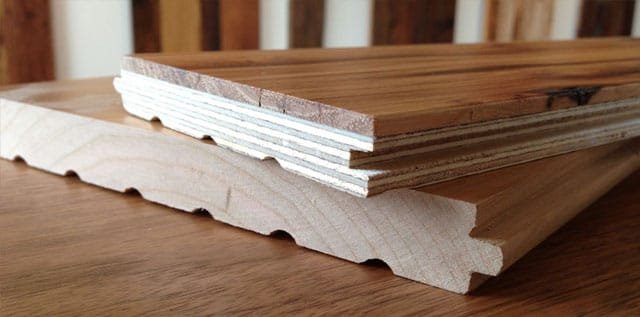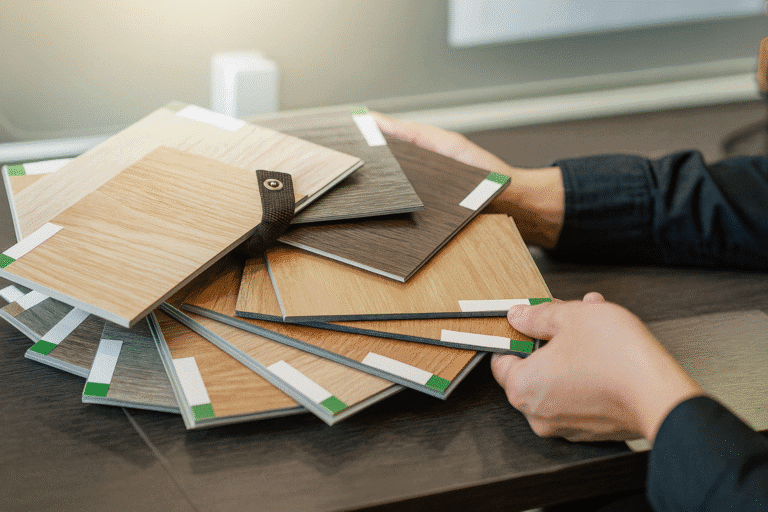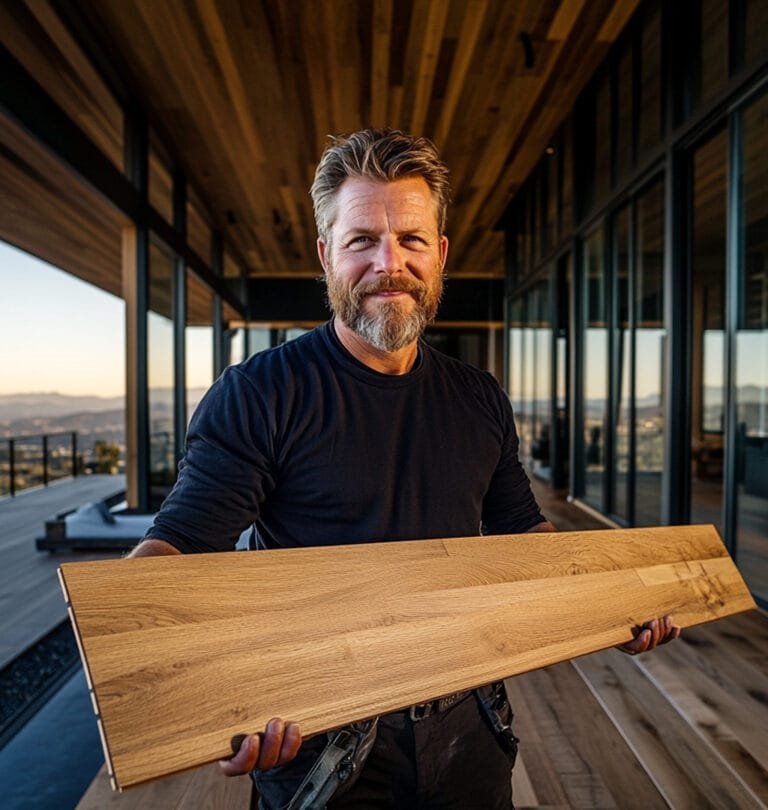Get expert advice and avoid the painful and costly mistakes most homeowners make!
Introduction to Hardwood Flooring
Choosing hardwood flooring is a popular choice for homeowners, thanks to its long-lasting appeal and the value it adds to any home. However, this investment can come with challenges if you’re unfamiliar with the essentials of hardwood types, installation, and maintenance. Many homeowners make costly mistakes that could have been avoided with a bit of upfront knowledge. This guide will help you understand key factors so you can make informed choices before you buy.
Choosing the Right Type of Hardwood for Your Home
Solid vs. Engineered Hardwood:
One of the first decisions you’ll face is choosing between solid and engineered hardwood. Solid hardwood is crafted from a single piece of wood, making it durable and suitable for refinishing multiple times. Engineered hardwood, however, features a thin layer of hardwood on top of a plywood or fiberboard base, providing increased moisture resistance and stability. Engineered wood is ideal for areas like basements or over radiant heating systems, while solid wood is better suited for low-humidity spaces.

Popular Wood Species and Their Benefits:
Popular wood types include oak, maple, and cherry, each with unique qualities. Oak is a durable classic with visible grain, making it a versatile choice for high-traffic areas. Maple, with its smooth grain, offers a more uniform look and a slightly harder surface. Cherry wood provides a rich, warm hue that deepens over time, adding character to any room. Understanding the strengths of each species will help you choose a wood type that aligns with your style and needs.
Grain, Color, and Finish Options:
Wood grain and color are key elements in setting the aesthetic tone of your home. Consider how various stains and finishes will interact with natural light in your space. Options range from glossy and reflective to matte, with choices like oil-based and water-based finishes affecting both color tone and durability.
Hardwood Floor Grading and Quality Standards
Understanding Wood Grades:
Hardwood flooring is graded based on appearance. For example, “Select” grade wood has minimal knots and is uniform in appearance, whereas “Rustic” grade includes more natural imperfections for a more distressed look. The choice of grade impacts not only the look of your floor but also its cost. If you are interested in knowing the base cost of materials and labor, leave a comment below.
Quality Indicators to Look For:
Hardwood quality can vary significantly, even within the same grade. Look for well-milled boards that are straight and smooth-edged, as this will help in creating a seamless installation. A high-quality hardwood floor will have consistent thickness and even tongue-and-groove joints.
How Grading Impacts the Look and Cost of Your Floor:
Selecting a lower grade hardwood can add character but may require additional maintenance. Higher-grade wood often carries a premium price but offers a more uniform look and better durability.
Durability and Lifespan Considerations
Hardwood Floor Hardness:
The hardness of hardwood is measured by the Janka scale, which indicates a wood’s resistance to dents and wear. Harder woods like oak and hickory are excellent for high-traffic areas, while softer woods like pine may be better suited to low-traffic or decorative spaces.
Maintenance Needs by Wood Type:
Different woods require different maintenance levels. For instance, softer woods may need more frequent refinishing, while denser woods like maple require less upkeep. Keeping your hardwood floors in optimal condition can prevent premature aging and increase their lifespan.
What Determines the Lifespan of Hardwood Floors?
The lifespan of a hardwood floor depends on factors such as wood type, traffic, maintenance, and environmental conditions. With proper care, quality hardwood floors can last for decades, making this investment one that pays off over time.
Installation Methods and Costs
Nail-Down, Glue-Down, and Floating Floors:
Different installation methods can affect both the cost and longevity of your hardwood floor. Nail-down installation is commonly used for solid wood and provides excellent stability. Glue-down installation is a popular choice for engineered wood, especially over concrete subfloors. Floating floors, where boards are clicked together without glue or nails, are suitable for engineered wood and offer flexibility in humid conditions.
Professional vs. DIY Installation:
While DIY installation can save money, it may lead to complications if done incorrectly. Hiring professionals ensures that the flooring is installed correctly, reducing the risk of warping or uneven surfaces. A professional installation may cost more initially but can prevent costly repairs later on.
Understanding Installation Costs and Avoiding Unnecessary Expenses:
Installation costs vary widely based on labor, flooring type, and additional treatments. Asking for detailed quotes and understanding what each cost includes will help you budget effectively.
Mistakes to Avoid When Buying Hardwood Floors
Choosing Cheap Over Quality:
Choosing lower-quality wood to save on initial costs can be a mistake, as cheaper materials are often less durable and may require early replacement. Opting for a higher-quality floor ensures a better look and a longer lifespan.
Ignoring Environmental Impact:
It’s essential to consider environmentally friendly options when buying hardwood. Look for certified sources that ensure sustainable forestry practices. Not only does this support environmental conservation, but it also ensures that your wood will be free from harmful chemicals.
Not Preparing for Maintenance Needs:
Different hardwoods have different maintenance needs. Understanding the upkeep requirements for your chosen wood type will help you avoid unexpected expenses down the road.
How to Make Your Hardwood Floors Last
Routine Care Tips for Longevity:
Regular sweeping, vacuuming, and occasional mopping with a wood-safe cleaner can help maintain your floors’ natural beauty. Refinishing every few years will also help to restore worn areas and extend the life of your hardwood floors.
Preventing Scratches and Dents:
To prevent damage, use furniture pads and area rugs in high-traffic areas. Additionally, implement a no-shoe policy or use a mat at the entrance to minimize scratches.
Humidity Control for Wood Floors:
Wood is sensitive to humidity changes, which can cause warping and shrinkage. Using a humidifier during dry winters and a dehumidifier in humid summers can help maintain stability.
Hardwood Floor Trends and Styles to Consider
Popular Looks in 2024:
This year, homeowners are drawn to wide-plank floors and rustic finishes that bring a sense of warmth and character to any room. Gray and whitewashed tones are trending, offering a modern twist on traditional wood floors.
Rustic vs. Modern Finishes:
From weathered, distressed finishes to high-gloss, modern styles, there’s a wide range of options. Rustic finishes add character and hide minor imperfections, while modern finishes provide a sleek, clean look.
How Trends Impact Resale Value:
Keeping up with flooring trends can make your home more appealing to potential buyers. Choosing a style that is both timeless and trendy can increase the resale value of your property.
Calculating the Total Costs of Hardwood Flooring
Beyond Materials:
It’s important to consider labor, delivery, underlayment, and installation tools in your budget. Additionally, factor in long-term maintenance costs like refinishing.
Budget-Friendly Alternatives:
For those on a budget, alternatives like engineered hardwood and bamboo offer a similar look for less. These options are often more moisture-resistant and environmentally friendly.
How to Plan for Long-Term Investment Value:
Choosing durable materials and planning for occasional refinishing can help your hardwood floors remain an asset for years to come. Proper care not only extends the lifespan of the floor but also enhances its appeal.
How to Select a Reliable Flooring Provider
What to Look for in a Flooring Company:
Choose companies with solid reviews, proper certifications, and clear warranties. Look for transparent pricing and quality service.
Questions to Ask Your Flooring Installer:
Make sure to ask about their experience, installation process, and whether they offer any guarantees. It’s also wise to confirm if they handle any unexpected repairs post-installation.
Red Flags to Avoid in Flooring Companies:
Watch out for companies with vague pricing or poor customer service. Avoid providers that aren’t licensed or insured, as this can lead to costly issues if problems arise.
Conclusion: Preparing to Invest Wisely in Hardwood Floors
Making an informed decision about hardwood flooring doesn’t just enhance your home’s beauty; it also protects your investment. By understanding the types of wood, installation methods, and maintenance needs, you’re better equipped to choose the right flooring that fits your lifestyle and budget. Whether you’re in the research stage or ready to buy, the insights in this guide will help you make the best choice for your home.




